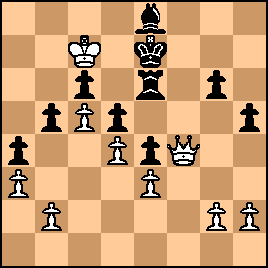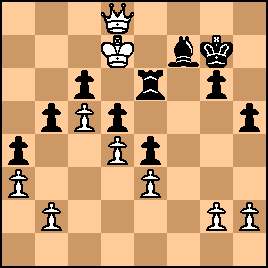|
< Earlier Kibitzing · PAGE 3 OF 3 ·
Later Kibitzing> |
| Jun-24-12 | | lost in space: aha, took me a while to understand:
27...Bf8 28. f7 Rc8 (Ra8 is worse as Ra8 is unprotected and so Black has not 31...Bf8 in case of a Qe8+) 29. Qf6+ Bg7 30. Qe7 Bf5 31. h3 (31. Qe8+ Bf8) h5 32. g4! hxg4 (otherwise the bishop is gone) 33. Qh4+ with mate to follow |
|
| Jun-24-12 | | drpoundsign: Why take the white king on a walk instead of checking with the Queen? (I'm not a very smart Man) |
|
| Jun-24-12 | | Everett: Radjabov likely pulled from his early work on the French and Dutch to create this masterpiece. |
|
| Jun-24-12 | | 5hrsolver: <drpoundsign: Why take the white king on a walk instead of checking with the Queen? (I'm not a very smart Man)> With Queen alone white wont be able to win more material. With the reduced black force the white king is not in danger of getting mated. It becomes an attacking piece. The white queen with the white king can deliver checkmate or win the bishop or rook. The queen can also give itself up for the bishop and rook and the advanced white king can then gobble up the black pawns. |
|
| Jun-24-12 | | Chessmaster9001: Combination starting with 24.Rf7 is just brilliant. Amazing game by Radja! |
|
| Jun-24-12 | | ajile: A very smart way to play for White in the opening. He transitions to a Stonewall Attack formation after first getting in the advance c5. So now Black's counterplay is greatly reduced since with 10.f4 White is also inhibiting the freeing e5 by Black. |
|
| Jun-24-12 | | fisayo123: <Its one of the standard set-ups against the chebanenko system. The one that irritates me the most at black bu usually without c5. |
|
| Jun-24-12 | | vinidivici: <shams> i c |
|
| Jun-25-12 | | Chessmaster9001: 27..a4 seems to be a final mistake, as 27..Rf8 was definitely better trying to stop the king`s march to the queen side. |
|
| Jun-25-12 | | kevin86: Interesting how the white king pentrated the position. Wow! |
|
| Jun-25-12 | | 5hrsolver: < Boomie & lost in space>
The other alternative is
(27...Bf8 28.f7 Rc8 29.Qf6+ Bg7 30.Qe7 Bf5 31.h3 Rf8 32.g4 Bc8 33.Qc7)and black is bound to lose a lot of pawns |
|
| May-17-24 | | FM David H. Levin: <Chessmaster9001: 27..a4 seems to be a final mistake, as 27..Rf8 was definitely better trying to stop the king`s march to the queen side.> Perhaps Black avoided 27...Rf8 because of 28.a4, which would prevent Black from creating a light-square pawn chain from the a- to e-files. Then after 28...bxa4, White's queen would probably pick up the a-pawns and maneuver to a square that would control d5 (such as e5). White then would threaten to advance the b-pawn to the fifth rank, intending to meet ...cxb5 by Qxd5..., with two connected passers. I'm not sure how Black would retain adequate control of c6 and d5 while avoiding loss of at least one kingside pawn and keeping White's king cut off along the f-file. |
|
| May-17-24 | | Mayankk: I saw the beautiful idea behind 24 Rf7 - Rook is immune to capture as Black Queen is hanging if 24 ... Bxf7. But after 24 ... Bxg4, I had the wrong followup of 25 Bh6. The idea was similar - 25 Bh6 Bxh6 26 Qxh6 and Black gets mated at h7. And 25 ... Rg8 26 h3 Be6 27 Rxe7 Qc8 28 Bxg7+ Rxg7 29 Qf6 Qg8 30 Rxg7 Qxg7 31 Qxe6 etc. means White is up a pawn and should grab a few more courtesy his strongly placed pawn. The complicated 25 Bf6 line was way beyond me. |
|
| May-17-24 | | vajeer: After White's 32.Kd2, I was curious whether black can form a fortress. For example
32...h5 33. Kc3 kf6 34.Qf4+ Ke7 35 Kb4 Bd7
Now black just shuttle the king in the center squares while keeping white king at bay? I wonder whether there is a fortress here? |
|
| May-17-24 | | mel gibson: I saw the first ply straight away.
Stockfish 16.1 says:
24. Rf7
(24. Rf7 (1.Rf7 Bxg4 2.Bf6 exf6 3.Rxd7 Bxd7 4.exf6 a4 5.fxg7+ Kxg7 6.Kf1 Rf8+ 7.Ke1 Rf7 8.Qg3 h6 9.Kd2
Re7 10.Kc3 Be8 11.Qd6 Kf7 12.Kb4 Re6 13.Qf4+ Kg7 14.Qc7+ Kf8 )
+4.71/57 1164)
score for White +4.71 depth 57. |
|
May-17-24
 | | scormus: Still trying to figure out where the LSB was so pinterested. On e6 after 24 Rf7 or on f7 after 39 Qf2 ;) Good punzle! |
|
May-17-24
 | | Sally Simpson: As always when solving these POTD's I go into what would I do mode. My first idea;
click for larger view24.Bh6 Bxg4 25.Bxg7+ Kxg7. 26.Rf7+ Kxf7 27.Qxh7+ is a neat looking perpetual. I would have gone for that and see what happens. If 24...Bxg4 I have the moral high ground. I've drawn being a Rook and Bishop down. Having seen the draw I doubt if I would have looked any further. 24.Rf7 is too unclear to fathom out especially when you have the distraction of a sac-sac perpetual on the board. |
|
May-17-24
 | | Teyss: Sunday already? Time flies.
After reading the posts above I finally understood why Black couldn't play 27...Bf8 but no clue if he could afterwards have established a fortress as pointed out by <vajeer>. |
|
May-17-24
 | | chrisowen: I jam q gap be it's wink it's haft it's old v u x Rf7 gab buck it's wig it's huh it's adagio it's nag abracadabra mib Rf7 cap |
|
| May-17-24 | | Saniyat24: The open f-road amongst all the traffic jam...! |
|
| May-17-24 | | King.Arthur.Brazil: First of all, the W K is not at h1 or any unseeing check-mate. Lgs. The King found 24. Rf7, ( firstly Bxf7?? 28. Bxd7, so its plausible). Bxg4 25. Bf6 (again: exf6 then 26.Qxd7 also win the enemy's ♕ and threates Rxg7 in drastic consequences. 26... Rg8 (seems forced) 27. Rxe7 (cannot 27. Qh6?? due to exf6) Qc8 (if Qd8, 28.Rxg7 W win). And here I gave up without seen a winning line. Then, I looked at the game (which confirmed my try, but I didn't understand why B not played 26... Rg8 (time trouble?).Is there's something I'm missing? |
|
| May-17-24 | | King.Arthur.Brazil: As <Teyss>, I don't like either B continuation (or SF): <27...Bf8> 28. f7 Rc8 29. Qf6+ Bg7 30. Qe7 Bf5 (f8=Q, Rxf8 and then what?). B can keep both (B) and maybe capture f7 later and turn around the table. E.g. 31. h3 Bf8 32. Qf6+ Bg7 33. Qh4 g5 34. Qxg5 Bg6 35. Qe7 Rf8 36. Qd6 Rxf7 37. Qxc6 Bh6 38. Qe8+ Rf8 39. Qe5+ Kg8 40. Qe6+ Bf7 41. Qg4+ Kh8 42. Qg3 Be8 43. Qe5+ Kg8 44. Qg3+ Kh8... at least a draw. |
|
| May-17-24 | | King.Arthur.Brazil: <Vajeer> After <32...h5 33. Kc3 Kf6 34. Qf4+ Ke7 35. Kb4 Bd7> answer you, B has not a fortress... 36. b3 axb3 37. Kxb3 Rf6 38. Qe5+ Re6 39. Qg5+ Rf6 40. Kb4 Be8 41. Ka5 Bd7 42. Kb6 Be8 43. Kc7 Bd7 44. Qxf6+ Kxf6 45. Kxd7 g5 46. Kxc6 Ke6 47. Kxb5 h4 48. c6 Kd6 49. Kb6 g4 50. c7 Kd7 51. Kb7... a similar plan you can do in other B' moves. Sometime, B will have a zugswang with the ♔-♖ pinned and no move to do. |
|
| May-17-24 | | whiteshark: If you take your time, you can definitely find the right sequence of moves here. It's more difficult with ADHD. |
|
| May-17-24 | | FM David H. Levin: <vajeer: After White's 32.Kd2, I was curious whether black can form a fortress. For example 32...h5 33. Kc3 kf6 34.Qf4+ Ke7 35 Kb4 Bd7 Now black just shuttle the king in the center squares while keeping white king at bay? I wonder whether there is a fortress here?> To try to answer that (and not having seen that <King.Arthur.Brazil> had addressed it), I considered a position likely to arise: 
click for larger viewBeing that White threatens mate in one, we'll give Black the move and
assume that White's last move was 101.Kb6 (where I'm arbitrarily
numbering that move).
<If now 101...Bd7, then 102.Qf7 wins at least a pawn. Or if 101...Re7, then
102.Qb8+ Kd7 103.Qd6+ wins the rook.>
101...Ke7 102.Kc7

click for larger view<If 102...Bd7, then 103.Qg5+ Rf6 104.Qxf6+ Kxf6 105.Kxd7, with a winning ending. Or if 102...Rf6, then 103.Qe5+ Re6 104.Qg7+ Bf7 105.h3 (Preparing to advance the g-pawn in order to control the f6-square.) 105...Rf6 106.g4 Re6 107.g5, and Black is movebound.> 102...Bf7 103.Qd6+ <If now 103...Rxd6, then 104.cxd6+ and soon promotes.> 103...Kf6 104.Qd8+ <If now 104...Re7+, then 105.Kd6 wins the rook. Or if
104...Kf5, then 105.h4 Rf6 106.Qe7 Be6 107.Kxc6.> 104...Kg7 105.Kd7 
click for larger view<If now 105...Kh7, then 106.Qf8 Rf6 107.Ke7 Rf2 108.Qxf7+ Rxf7+ 109.Kxf7.> 105...Rf6 106.h4 Bg8 107.Qe8 <Threatening 108.Qe5 with 109.Ke7.> 107...Kh7 108.Qe5 <The start of a triangulation.> 108...Rf5 109.Qb8 Rf6 110.Qe8 
click for larger view<Now Black is movebound: 110...Kg7 111.Qe5 Kf7 112.Qe7 mate; 110...Re6
111.Qxe6 Bxe6+ 112.Kxe6; 110...Bf7 111.Qe7.> This is hardly an exhaustive examination of the ending after <vajeer>'s suggested 32...h5. Still, it doesn't give me confidence that Black can somehow draw. |
|
 |
 |
|
< Earlier Kibitzing · PAGE 3 OF 3 ·
Later Kibitzing> |





































